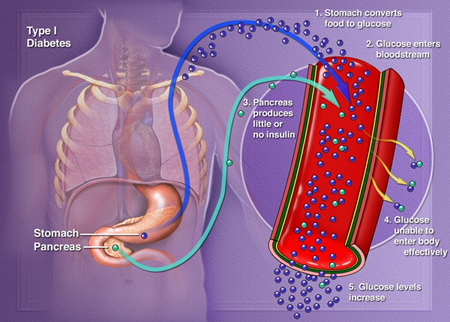Team members
Names / Roles:
- [Mas Ayu] (Leader)
- [Shaaista] (Editor)
- [Aisyah] (Researcher)
- [Jannah] (Researcher)
- [Angela] (Writer)
Meaning / Definition
Diabetes is a long-term condition that causes high blood sugar levels.It is a condition whereby by the body is unable to utilise glucose in the body effectively. So the blood glucose levels remain constantly high. Diabetes (diabetes mellitus) is classed as a metabolism disorder. Metabolism refers to the way our bodies use digested food for energy and growth. Most of what we eat is broken down into glucose. Glucose is a form of sugar in the blood - it is the principal source of fuel for our bodies.
When our food is digested, the glucose makes its way into our bloodstream. Our cells use the glucose for energy and growth. However, glucose cannot enter our cells without insulin being present - insulin makes it possible for our cells to take in the glucose.
what is insulin?
Insulin is a hormone made by the pancreas that allows your body to use sugar (glucose) from carbohydrates in the food that you eat for energy or to store glucose for future use. Insulin helps keeps your blood sugar level from getting too high or too low.The cells in your body need sugar for energy. However, sugar cannot go into most of your cells directly. After you eat food and your blood sugar level rises, cells in your pancreas (known as beta cells) are signaled to release insulin into your bloodstream. Insulin then attaches to and signals cells to absorb sugar from the bloodstream. Insulin is often described as a “key,” which unlocks the cell to allow sugar to enter the cell and be used for energy.
There are 2 type of Diabetes:
-Type 1 diabetes
People with type 1 diabetes cannot make insulin because the beta cells in their pancreas are damaged or destroyed. Therefore, these people will need insulin injections to allow their body to process glucose.People usually develop type 1 diabetes before their 40th year, often in early adulthood or teenage years.They must also ensure proper blood-glucose levels by carrying out regular blood tests and following a special diet.

-Type 2 diabetes
People with type 2 diabetes do not respond well or are resistant to insulin. They may need insulin shots to help them better process sugar and to prevent long-term complications from this disease. Overweight and obese people have a much higher risk of developing type 2 diabetes compared to those with a healthy body weight. The risk of developing type 2 diabetes is also greater as we get older.

Signs and Symptoms
Common warnings signs of diabetes include:
- Increased thirst.
- Increased hunger (especially after eating)
- Dry mouth.
- Frequent urination or urine infections.
- Unexplained weight loss (even though you are eating and feel hungry)
- Fatigue (weak, tired feeling)
- Blurred vision.
- Headaches.


Prevention and Treatment
1)Treatment
Diabetes type 1 lasts a lifetime, there is no known cure. Type 2 usually lasts a lifetime, however, some people have managed to get rid of their symptoms without medication, through a combination of exercise, diet and body weight control.
Patients with type 1 are treated with regular insulin injections, as well as a special diet and exercise.
Patients with Type 2 diabetes are usually treated with tablets, exercise and a special diet, but sometimes insulin injections are also required.
If diabetes is not adequately controlled the patient has a significantly higher risk of developing complications.
2)Prevention
In general, prevention starts with
- Better lifestyle
- Eating healthier
- Being physically active
- Take medicine as directed
- No smoking
- Control blood pressure
- Have regular health check up
- Have blood sugar checked along with weight, blood pressure and feeling
- Don't eat too much food that contains sugar, eat healthy and exercise regularly.
Natural therapies such as deep abdominal breathing progressive, muscle relaxation, guided imaginary can help relieve stress and emotional stress. So learning to relax is important in managing your diabetes.It needs to take several insulin injections everyday , monitor the blood sugar levels , to eat healthy foods that contains carbohydrate , regular excerise , regular medical checkups , don't smoke and last of all do not eat drugs when you are at risk for periods of low blood.
 Diabetes Prevention: 2012 update - Baltimore Disease Prevention ...
Diabetes Prevention: 2012 update - Baltimore Disease Prevention ...
Link to Other Illnesses or Diseases
Cardiovascular disease is the leading causing of death for people who have diabetes. That's because high blood sugar can cause a gradual buildup of fatty deposits that clog and harden the walls of blood vessels.And when blood vessels are partially blocked or narrowed, it can lead to a stroke or heart attack.
- stroke - a sudden disabling attack or loss of consciousness caused by an interruption in the flow of blood to the brain
- heart attack - a sudden occurrence of coronary thrombosisa (blockage of the flow of blood to the heart), typically resulting in the death of part of a heart muscle and sometimes fatal.
https://en.wikipedia.org/wiki/Coronary_artery_disease
References
Plagiarism is a strongly discouraged.
https://www.google.com.sg/search?
Comments (3)
Mr Reuben Ng said
at 7:42 pm on Jun 9, 2015
Please start on your project soon!
Mr Reuben Ng said
at 3:22 pm on Jun 27, 2015
Do add pictures!
Mr Reuben Ng said
at 3:27 pm on Jun 27, 2015
Make sure the font size is the same
You don't have permission to comment on this page.